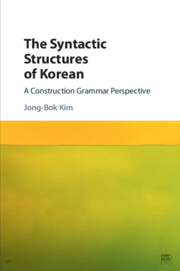Book contents
- Frontmatter
- Contents
- Acknowledgments
- Abbreviations
- 1 Theoretical foundations
- 2 Noun phrases
- 3 Case system
- 4 Auxiliary and complex predicate constructions
- 5 Gerund phrases and mixed categories
- 6 Verbal nouns and light verb constructions
- 7 Serial verb constructions
- 8 Negation and related phenomena
- 9 Coordination
- 10 Passive constructions
- 11 Wh-questions
- 12 Topic and focus constructions
- 13 Relative clause constructions
- 14 Honorification
- References
- Index
11 - Wh-questions
Published online by Cambridge University Press: 05 July 2016
- Frontmatter
- Contents
- Acknowledgments
- Abbreviations
- 1 Theoretical foundations
- 2 Noun phrases
- 3 Case system
- 4 Auxiliary and complex predicate constructions
- 5 Gerund phrases and mixed categories
- 6 Verbal nouns and light verb constructions
- 7 Serial verb constructions
- 8 Negation and related phenomena
- 9 Coordination
- 10 Passive constructions
- 11 Wh-questions
- 12 Topic and focus constructions
- 13 Relative clause constructions
- 14 Honorification
- References
- Index
Summary
Korean is a wh-in-situ language in the sense that the wh-expression stays in situ with an obligatory Q-particle marking its interrogative scope. This chapter reviews some basic properties of the wh-question construction in Korean and shows how a constraint- and construction-based HPSG can provide a robust, precise analysis of the wh-construction in the language.
Dependency between wh-question and Q-particle
Unlike English, Korean is a wh-in-situ language where the wh-word stays in the original position (see, among others, Hagstrom 1998, Chung 2000, Kim 2000, and Hong 2005).
(1) a. ecey Mimi-ka nwukwu-lul manna-ss-ni?
yesterday Mimi-NOM who-ACC meet-PST-QUE
‘Who(m) did Mimi meet yesterday?’
b. ecey nwu-ka Mimi-lul manna-ss-ni?
yeterday who-NOM Mimi-ACC meet-PST-QUE
‘Who met Mimi yesterday?’
As seen from these examples, unlike English, there is no displacement (or movement) of the wh-phrase in forming the wh-questions. The wh-expression in Korean need not move to the clausal scope (clause-initial) position, though it can be optionally displaced to the position through a scrambling process:
(2) nwukwu-lul ecey Mimi-ka manna-ss-ni?
who-ACC yesterday Mimi-NOM meet-PST-QUE
‘Who(m) did Mimi meet yesterday?’
In forming a wh-question in the language, all that is required is the presence of a Q-particle. That is, the wh-expression requires a question mood marking (Q-particle) like -ni on the matrix verb to have an interrogative meaning.Without such a Q-particle, the wh-expression can be interpreted as an indefinite pronoun (see Chung 1996, Kim 2000, Hong 2005):
(3) a. Mimi-ka mwues-ul mek-ess-ta
Mimi-NOM what-ACC eat-PST-DECL
‘Mimi ate something.’
b. nwu-ka Mimi-lul manna-ss-ta
who-NOM Mimi-ACC meet-PST-DECL
‘Someone met Mimi.’
The wh-expression is thus ambiguous between an interrogative reading and an indefinite reading, depending on the presence of the Q-particle.
The Q-particle can be attached to the final verb of a clause located to the right of the corresponding wh-element, marking its scope, as illustrated by the following:
(4) a. Embedded clause wh-question
Haha-nun [Mia-ka mwues-ul sa-ss-nunci] mwul-ess-ni?
Haha-TOP Mia-NOM what-ACC buy-PST-QUE ask-PST-QUE
‘Did Haha ask what Mia bought?’
#‘What did Haha ask if Mia bought?’
b. Matrix clause wh-question
Haha-nun [Mia-ka mwues-ul sa-ss-ta-ko]
Haha-TOP Mia-NOM what-ACC buy-PST-DECL-CONN
malha-yess-ni?
say-PST-QUE
‘What did Haha say Mia bought?’
In both cases, the wh-question is in the embedded clause but the position of the Q-particle differs.
- Type
- Chapter
- Information
- The Syntactic Structures of KoreanA Construction Grammar Perspective, pp. 242 - 255Publisher: Cambridge University PressPrint publication year: 2016



